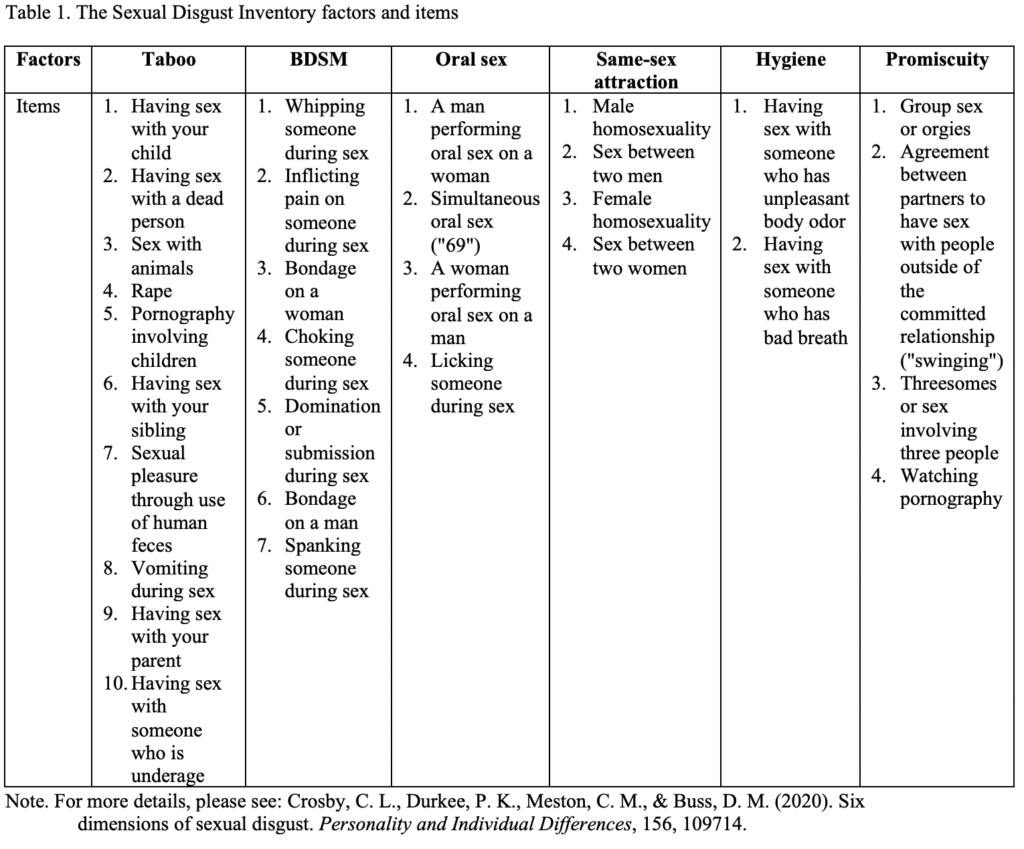Courtney L. Crosby and David M. Buss[1]


Introduction
One of the first emotions explored by Charles Darwin, disgust, presumably evolved to solve adaptive problems related to our health. Examples of these problems include avoiding ingesting toxic or pathogenic substances, such as rotting meat or moldy mushrooms. However, a key scientific question is whether disgust evolved to solve adaptive challenges in addition to food consumption. Darwin described disgust as a revulsion to offensive objects, primarily those of taste, but extended to anything that causes extreme dislike or distaste—through vision, smell, or touch (Darwin, 1872). While avoiding contaminated food is a key adaptive problem that our human ancestors faced, they also had to avoid having sex with individuals that could harm their survival, their children’s survival, or more generally their reproductive success. Sexual disgust may have evolved as a somewhat specialized emotion—based on the underlying architecture of disgust—to solve these problems (Tybur, Lieberman, & Griskevicius, 2009).
Adaptive Problems Sexual Disgust is Hypothesized to Solve
If sexual disgust is an evolved emotion, what adaptive problems might it have evolved to solve? We have recently developed evolutionarily informed speculations about these problems that await empirical testing. We identified six core dimensions of sexual disgust: (1) Hygiene, (2) Oral sex, (3) Promiscuity, (4) Same-sex attraction, (5) BDSM, and (6) Taboo (Crosby, Durkee, Meston, & Buss, 2020). Each dimension represents partially distinct subcomponents of sexual disgust that, together, provide more nuanced insight into the complexity of human sexual behavior. Sexual disgust towards the behaviors subsumed by these six factors represents hypothesized solutions to somewhat distinct adaptive problems that our ancestors faced within the realm of sexuality (see Table 1 for the full list of items grouped by factor).

Critical adaptive problems include pathogen transmission, incest avoidance, harm avoidance, reputational damage, and the loss of valuable resources or mates. For example, increased risk of pathogen transmission is an important adaptive problem that individuals face when engaging in sex. A single French kiss, for example, can transmit as many as 80 million bacteria from one person’s mouth to the other’s (Kort, Caspers, van de Graaf, van Egmond, Keijser, & Roeselers, 2014). Although most of these bacteria are harmless, pathogen transmission can lead to a variety of harmful health issues, such as sexually transmitted infections (STIs). This problem can be solved through an adaptation that triggers the avoidance of mates with cues that are probabilistically linked to an increased rate of disease transmission. Cues carried by a potential sex partner might include poor hygiene, facial acne, lip or mouth lesions, genital sores, or interest in sexual activities involving bodily substances. These cues are hypothesized to activate sexual disgust and lead to the avoidance of sexual activities with potential mates who possess them. We hypothesize that sexual disgust towards items subsumed by the Hygiene, Oral sex, or Promiscuity factors, as well as towards the deviant sex subscale of the Taboo factor, also function to avoid sexual contact with pathogenic vectors.
Another category of costly sexual partners is genetic relatives. Offspring produced by inbreeding have a less diverse allelic combination, are more susceptible to infection, and experience a higher risk of blindness, deafness, malformed limbs, and psychological disorders such as schizophrenia (e.g., Lieberman & Smith, 2012; Lieberman, Fessler, & Smith, 2011; Lieberman, Tooby, & Cosmides, 2007). Previous research confirms that most individuals consider sex between relatives psychologically or emotionally unsettling (Ackerman, Kenrick, & Schaller, 2007; Haidt, Bjorklund, & Murphy, 2000). Our studies corroborate previous research; we found that people are particularly sexually disgusted by the idea of sex with three classes of close genetic relatives: parents, children, and siblings. Specifically, disgust towards sex with these classes of genetic relatives—which are subsumed under the incest subscale of the Taboo factor—is hypothesized to prevent individuals from engaging in sexual activities that produce these deleterious consequences. All else equal, increased genetic relatedness should result in higher levels of sexual disgust and avoidance of sexual contact. Future research could also investigate whether individuals feel the same level of sexual disgust towards psychologically close, but genetically unrelated, relatives such as step-siblings or step-parents.
Another critical adaptive problem that individuals, particularly women, might face during sexual encounters is suffering from physical violence. Physical violence during sex can result in a host of negative effects, ranging from open wounds to post-traumatic stress disorder or sexual dysfunction (Jina & Thomas, 2013; Turchik & Hassija, 2014). Several items on the BDSM factor represent activities that may lead to physical harm when practiced unsafely. Individuals who engage in consensual BDSM typically have a pre-established safe word, which presumably functions to prevent activities that can cause real harm (Jozifkova, 2013). Sexual disgust towards the items subsumed under the BDSM factor may also operate to prevent individuals from engaging in sexual activities that may lead to physical harm if practiced unsafely.
In sum, these evolutionarily informed hypotheses suggest that sexual disgust is an evolved emotion that functions to avoid hazards such as pathogen vectors transmitted through sexual contact and harms caused by inbreeding and sexual violence.
Sex Differences in Sexual Disgust
In contrast to minimal sex differences in many psychological domains, women and men differ dramatically in their baseline levels of sexual disgust. On average, women are more sexually disgusted than men. These sex differences are large and highly replicable, with effect sizes, as measured by Cohen’s ds, ranging from .60 to 1.54 (Al-Shawaf, Lewis, & Buss, 2018).
A number of evolutionarily informed hypotheses have been advanced that might explain these large sex differences (Al Shawaf et al., 2018). These include (1) the parental investment hypothesis, which suggests women’s higher levels of sexual disgust may stem from the greater costs they face from injudicious sexual choices; (2) the sexually transmitted infections hypothesis, which suggests that because women’s genital anatomy renders them more vulnerable to communicable diseases compared to that of men, they may have higher levels of sexual disgust; (3) the rape avoidance hypothesis, which suggests that some forms of sexual disgust help women to avoid contact with sexually coercive men; and (4) the reputational damage hypothesis, which suggests that women may have higher levels of sexual disgust because they face higher costs, such as a decline in perceived mate value, when being socially labeled as promiscuous. Moreover, contaminations and infections contracted through sexual contact are more likely to be passed from mother to infant or young child than from father to offspring due to lactation and greater maternal physical contact with offspring. Tests of which of these factors, or which combination of factors, best explains the large sex difference in sexual disgust remain to be conducted.
Some scientific clues, however, may be found in our own research. For example, we found the largest sex difference among our six factors of sexual disgust on the Promiscuity factor, which assess attitudes towards non-monogamous sex (Crosby et al., 2020). Women were significantly more sexually disgusted than were men by these sexual activities across two independent studies. Since having multiple sex partners puts women at greater risk than men of STIs, exposes women to more sexually coercive contexts, and is linked to an increased risk of reputational damage, these findings provide circumstantial support for the second, third, and fourth hypotheses.
The Computational Structure of Sexual Disgust
To solve these critical adaptive problems and sex differences, sexual disgust must become activated within appropriate contexts. As a result, sexual disgust is hypothesized to be calibrated to many context-specific input variables, such as mate availability, genetic relatedness, and mate-value (Lieberman & Patrick, 2018, pp. 94). It is further hypothesized that together, these inputs are weighted to trigger an internal regulatory system that calculates an expected sexual value—a surrogate marker for ancestral reproductive costs and benefits—of each partner or situation. If the expected sexual value of a particular sexual situation or partner is low, sexual disgust and avoidance of sex is hypothesized to be the behavioral output. Conversely, a high expected sexual value is hypothesized to lead to a lack of sexual disgust and approach of the sexual situation.
For example, people generally try to pursue potential partners of high mate value—those who are healthy, attractive, socially skilled, or rich in allies and resources. This is a strategy that reaps high rewards when it works effectively. However, if there is a small pool of potential mates to choose from (i.e., low mate availability), being increasingly choosy may impair an individual’s success by rendering them unable to obtain any partner at all (Daly & Wilson, 2001). Sexual disgust in this context may therefore be downregulated—albeit unconsciously through this internal regulatory system—in order to increase the chances of successfully procuring a mate.
Previous studies and measures of sexual disgust have not captured the full range of important adaptive problems that individuals must navigate in the sexual sphere. The different context-specific inputs that can activate sexual disgust and the many adaptive problems that individuals must solve is corroborated by our empirical discovery that sexual disgust has a multi-dimensional structure (Crosby et al., 2020). Future research should investigate how the context-specific inputs that underlie our six-factor measure of sexual disgust are weighted in a range of different contexts, and how these differ for men and women.
Sexual Disgust Interacts with Other Psychological and Physiological Systems
Previous research also provides evidence that sexual disgust is linked to other emotions and psychological processes. For example, research suggests that sexual disgust has an inhibitory effect on sexual arousal and that it is involved in the development and maintenance of sexual pain disorders in women (see Crosby, Buss, & Meston, 2019 for a review). Sexual disgust has been shown to have an inhibitory effect on short-term mating interest—inducing sexual disgust leads to a reduction in short-term mating interest above and beyond the induction of pathogen disgust (Al-Shawaf et al., 2019). Evidence also shows that individuals interested in sexual variety, that is dispositionally inclined to short-term mating, tend to have lower average ratings of sexual disgust compared to their long-term mating-oriented counterparts (Al-Shawaf, Lewis, & Buss, 2015; O’Shea, DeBruine, & Jones, 2019; Tybur & Gangestad, 2011). Understanding how sexual disgust influences, and is influenced by, other psychological systems, such as sexual arousal and the proclivity to pursue different mating strategies, renders exploration of this emotion of considerable scientific interest.
Conclusion
In summary, the evidence for six dimensions of sexual disgust as discovered through our research suggests multiple domains toward which sexual disgust might be directed. The inclusion of these six factors of sexual disgust is critical in exploring (1) the different adaptive problems that sexual disgust is hypothesized to solve, (2) the origins of sex differences in sexual disgust, (3) the computational architecture of this emotion (i.e., the inputs, procedures, and behavioral outputs of this emotion), (4) and how this emotion relates to other aspects of sexuality such as sexual functioning, sexual strategies, or sexual satisfaction. The evolutionary hypotheses advanced to explain the different facets of sexual disgust offer heuristic value, and should help guide future researchers to explore this relatively uncharted emotion.
References
Ackerman, J. M., Kenrick, D. T., & Schaller, M. (2007). Is friendship akin to kinship? Evolution and Human Behavior, 28, 365–374.
Al-Shawaf, L., Lewis, D. M., Ghossainy, M. E., & Buss, D. M. (2019). Experimentally inducing disgust reduces desire for short-term mating. Evolutionary Psychological Science, 5(3), 267-275.
Al-Shawaf, L., Lewis, D. M., & Buss, D. M. (2018). Sex differences in disgust: Why are women more easily disgusted than men?. Emotion review, 10(2), 149-160.
Al-Shawaf, L., Lewis, D. M., & Buss, D. M. (2015). Disgust and mating strategy. Evolution and Human Behavior, 36(3), 199-205.
Crosby, C. L., Durkee, P. K., Meston, C. M., & Buss, D. M. (2020). Six dimensions of sexual disgust. Personality and Individual Differences, 156, 109714.
Crosby, C. L., Buss, D. M., & Meston, C. M. (2019). Sexual disgust: Evolutionary perspectives and relationship to female sexual function. Current Sexual Health Reports, 11(4), 300-306.
Daly, M., & Wilson, M. (2001). Risk-taking, intrasexual competition, and homicide. In J. A. French, A. C. Kamil, & D. W. Leger (Eds.), Vol. 47 of the Nebraska symposium on motivation. Evolutionary psychology and motivation (pp. 1–36). University of Nebraska Press.
Darwin, C. (1872). The origin of species by means of natural selection: or, the preservation of favoured races in the struggle for life and the descent of man and selection in relation to sex. Modern library.
Haidt, J., Bjorklund, F., & Murphy, S. (2000). Moral dumbfounding: When intuition finds no reason. Unpublished manuscript, University of Virginia.
Jina, R., & Thomas, L. S. (2013). Health consequences of sexual violence against women. Best Practice & Research Clinical Obstetrics & Gynecology, 27(1), 15-26.
Jozifkova, E. (2013). Consensual sadomasochistic sex (BDSM): The roots, the risks, and the distinctions between BDSM and violence. Current Psychiatry Reports, 15(9), 392.
Kort, R., Caspers, M., van de Graaf, A., van Egmond, W., Keijser, B., & Roeselers, G. (2014). Shaping the oral microbiota through intimate kissing. Microbiome, 2(1), 41.
Lieberman, D., & Patrick, C. (2018). Objection: disgust, morality, and the law (pp. 72-108). Oxford University Press.
Lieberman, D., & Smith, A. (2012). It’s all relative. Current Directions in Psychological Science, 21(4), 243–247.
Lieberman, D., Fessler, D. M. T., & Smith, A. (2011). The relationship between familial resemblance and sexual attraction: An update on Westermarck, Freud, and the incest taboo. Personality and Social Psychology Bulletin, 37(9), 1229–1232.
Lieberman, D., Tooby, J., & Cosmides, L. (2007). The architecture of human kin detection. Nature, 445(7129), 727.
O’Shea, K. J., DeBruine, L. M., & Jones, B. C. (2019). Further evidence for associations between short-term mating strategy and sexual disgust. Personality and Individual Differences, 138, 333-335.
Turchik, J. A., & Hassija, C. M. (2014). Female sexual victimization among college students: Assault severity, health risk behaviors, and sexual functioning. Journal of Interpersonal Violence, 29(13), 2439-2457.
Tybur, J. M., & Gangestad, S. W. (2011). Mate preferences and infectious disease: Theoretical considerations and evidence in humans. Philosophical Transactions of the Royal Society B: Biological Sciences, 366(1583), 3375-3388.
Tybur, J. M., Lieberman, D., & Griskevicius, V. (2009). Microbes, mating, and morality: Individual differences in three functional domains of disgust. Journal of Personality and Social Psychology, 97(1), 103.
Weiss, M. D. (2006). Mainstreaming kink: The politics of BDSM representation in US popular media. Journal of Homosexuality, 50(2-3), 103-132.
[1] Corresponding author contact info: dbuss@austin.utexas.edu, 108 E. Dean Keeton St., A8000, Seay Psychology Building, Austin, Texas, 78712




